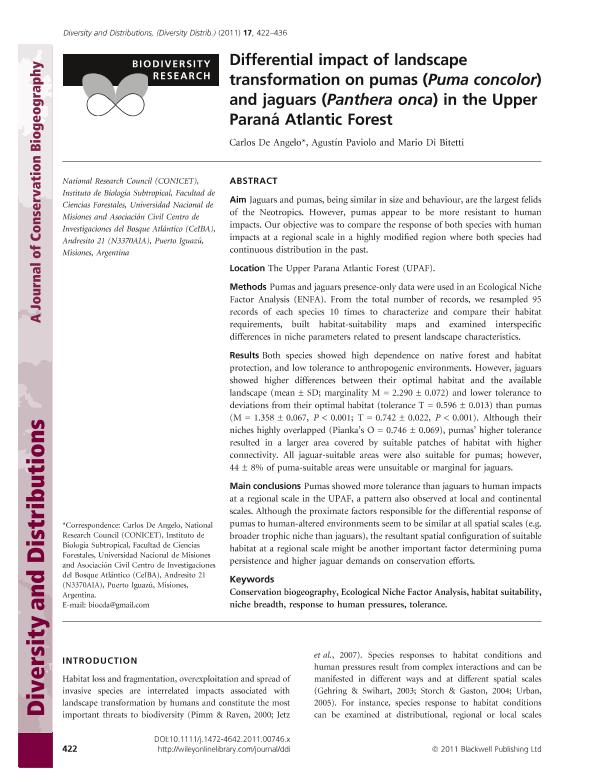Artículo
Differential impact of landscape transformation on pumas (Puma concolor) and jaguars (Panthera onca) in the Upper Paraná Atlantic Forest
Fecha de publicación:
05/2011
Editorial:
Wiley Blackwell Publishing, Inc
Revista:
Diversity and Distributions
ISSN:
1366-9516
e-ISSN:
1472-4642
Idioma:
Inglés
Tipo de recurso:
Artículo publicado
Clasificación temática:
Resumen
Aim Jaguars and pumas, being similar in size and behaviour, are the largest felids of the Neotropics. However, pumas appear to be more resistant to human impacts. Our objective was to compare the response of both species with human impacts at a regional scale in a highly modified region where both species had continuous distribution in the past.
Location The Upper Parana Atlantic Forest (UPAF).
Methods Pumas and jaguars presence‐only data were used in an Ecological Niche Factor Analysis (ENFA). From the total number of records, we resampled 95 records of each species 10 times to characterize and compare their habitat requirements, built habitat‐suitability maps and examined interspecific differences in niche parameters related to present landscape characteristics.
Results Both species showed high dependence on native forest and habitat protection, and low tolerance to anthropogenic environments. However, jaguars showed higher differences between their optimal habitat and the available landscape (mean ± SD; marginality M = 2.290 ± 0.072) and lower tolerance to deviations from their optimal habitat (tolerance T = 0.596 ± 0.013) than pumas (M = 1.358 ± 0.067, P < 0.001; T = 0.742 ± 0.022, P < 0.001). Although their niches highly overlapped (Pianka’s O = 0.746 ± 0.069), pumas’ higher tolerance resulted in a larger area covered by suitable patches of habitat with higher connectivity. All jaguar‐suitable areas were also suitable for pumas; however, 44 ± 8% of puma‐suitable areas were unsuitable or marginal for jaguars.
Main conclusions Pumas showed more tolerance than jaguars to human impacts at a regional scale in the UPAF, a pattern also observed at local and continental scales. Although the proximate factors responsible for the differential response of pumas to human‐altered environments seem to be similar at all spatial scales (e.g. broader trophic niche than jaguars), the resultant spatial configuration of suitable habitat at a regional scale might be another important factor determining puma persistence and higher jaguar demands on conservation efforts.
Archivos asociados
Licencia
Identificadores
Colecciones
Articulos(CCT - NORDESTE)
Articulos de CTRO.CIENTIFICO TECNOL.CONICET - NORDESTE
Articulos de CTRO.CIENTIFICO TECNOL.CONICET - NORDESTE
Citación
de Angelo, Carlos Daniel; Paviolo, Agustin Javier; Di Bitetti, Mario Santiago; Differential impact of landscape transformation on pumas (Puma concolor) and jaguars (Panthera onca) in the Upper Paraná Atlantic Forest; Wiley Blackwell Publishing, Inc; Diversity and Distributions; 17; 3; 5-2011; 422-436
Compartir
Altmétricas




